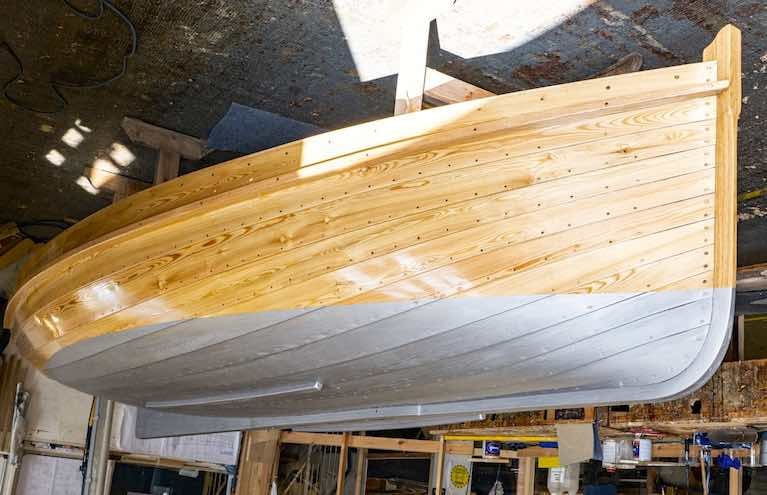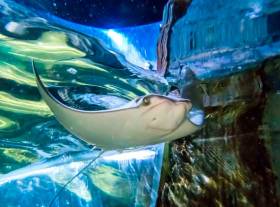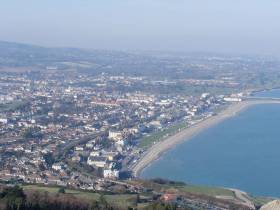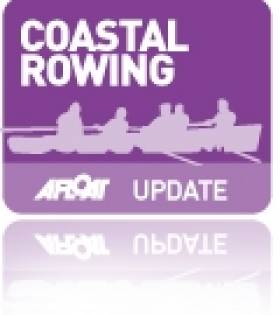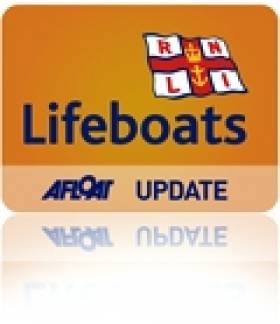Displaying items by tag: Bray
The Bray Droleen is the Cat's Whiskers on Her Maiden Sail
Every summer since 1997, the historic and picturesque English Jurassic Coast town of Lyme Regis (think Jeremy Irons & Meryl Streep in the 1981 multiple Oscar-nominated movie The French Lieutenant's Woman) has enjoyed the quaint ceremony of the Launching of the Boat Building Academy's New Flotilla.
As they've now sent forth around 120 boats of every sort, it's highly likely that the output at some stage has produced something with an Irish flavour. But at this year's launching, that Irish presence was very strong indeed with the new 12ft Bray Droleen, the historic One-Design of north County Wicklow built under instruction and guidance in Lyme Regis by retired school-teacher Michael Weed of Gweedore in Donegal,
Normally an August happening, the 2020 launching was Covid-postponed until the end of this week, with no crowd of supporters, and social distancing among all directly involved. But the excitement was palpable, as everything had to go precisely to plan in order to slip into a brief weather window.
 Diversity is everything in the Boat Building Academy's output – this year's flotilla of six boats included a West Wight Scow (left) and the 12ft Bray Droleen (right), seen here demonstrating her comfortable weight-carrying capacity with three adults on board
Diversity is everything in the Boat Building Academy's output – this year's flotilla of six boats included a West Wight Scow (left) and the 12ft Bray Droleen (right), seen here demonstrating her comfortable weight-carrying capacity with three adults on board
Then too, Michael and his two building team-mates – Peter Jakobsen from Denmark and Joseph Haines from London – had undertaken a particularly challenging project, for as already revealed in Afloat.ie, the clinker-built construction of the Bray Droleen to the precise 1896 plans of W Ogilvy involves some quite extreme steaming and twisting of the planking – particularly the garboard strakes – in order to get the required shape.
But in the workshop, the very elegantly-finished boat was clearly right up to top professional standards. So now everything hinged on her performance afloat, which was a matter of intense speculation, as the low-slung cat rig didn't really look like a performance proposition to seasoned observers.
Yet as this video reveals, the beamy little boat can zip along with the best of them:
And as for versatility, despite being just 12ft long she proved herself well able to comfortably carry four adults "of substantial size".
The new boat was launched with a gentle libation of Black Bush whiskey from Bushmills, the favourite tipple of Michael's late father-in-law, a Bonner of Gweedore. But as yet, this latest manifestation of the rare Bray Droleen has not been given a name.
"That will of course be decided democratically by a family choice back in Donegal," says Michael. "However, after months of work learning how to clinker-build a boat to this standard, if I don't like the name, I reserve the right to censor it…………"
 The Droleen building team were (left to right) Joseph Haines (London), Michael Weed (Donegal), and Peter Jakobsen (Denmark). In the yearly boat-building class of 18, each trainee has to submit the plans of the boat he or she wants to build, but only six boats make it through the selection process. Those whose proposals have failed to make the cut then join the three-person team on one of the selected boats.
The Droleen building team were (left to right) Joseph Haines (London), Michael Weed (Donegal), and Peter Jakobsen (Denmark). In the yearly boat-building class of 18, each trainee has to submit the plans of the boat he or she wants to build, but only six boats make it through the selection process. Those whose proposals have failed to make the cut then join the three-person team on one of the selected boats.
Bray's Droleen Dinghy Will Sail Again from Jurassic Coast Boat-Building School
When small boat sailing enthusiast W Ogilvy of Bray in County Wicklow persuaded seven of his friends to join him in 1896 in creating a new 12ft sailing dinghy class to his own design for local beach use, even the most casual observer could see that the eight Droleens ("Wrens") that resulted diverged significantly from the world-pioneering Water Wag One-Design dinghies.
The Water Wags had first made their appearance nine years previously a couple of miles to the north, sailing off the beach at Shankill. But by the time the Droleens were having their first full season in 1897, the Wags had long since moved their focus to Kingstown Harbour, where by this time they were numbered in the dozens.
The nearest they now got to Bray was an annual picnic cruise to Dalkey Island. Yet for those who had an opportunity to compare each boat type, it looked as though Ogilvy had set out to create a boat as different as possible from that specified by the Wags' founding father, Ben Middleton.
 Hang on to your hats, we have lift-off – Water Wag pioneers launching off Shankill Beach. Photo courtesy Vincent Delany
Hang on to your hats, we have lift-off – Water Wag pioneers launching off Shankill Beach. Photo courtesy Vincent Delany
Middleton's original Water Wag was a fairly slim double-ender some 13ft long, with a beam of 4ft 10ins, and stern quarters so narrow that the helmsman tended to locate amidships. The new Droleens were slightly shorter at only 12ft long, but with an extraordinary beam of half that, their hull volume may well have been twice as much as the Water Wags. And the Droleen's remarkable width of 6ft is put into further perspective when it's realized that the International 12, a transom-sterned design of 1913 still popular in many places and recently revived as a class in Dun Laoghaire, makes do with a beam of 4ft 8ins.
 "Broad in front, and broad behind…." Droleens on the beach in Bray
"Broad in front, and broad behind…." Droleens on the beach in Bray
Ogilvy had said that he wanted to create a roomy and robust boat that would be well able for launching from the beach at Bray, which reputedly was occasionally prone to be even rougher than Shankill. Maybe so, but a beach-kept boat has to think in terms of retrieval as much as launching, and it could well be that during their brief sojourn in Shankill, the pointed stern of the Water Wags was a more manageable proposition in surf when being brought hurriedly ashore, whereas the broad transom of the Droleens was just asking to have breaking waves crash very wetly against and over it.
Once out at sea, however, the Droleen was in a league of her own for spaciousness and comfort, so much so that the one photo we have of a Droleen sailing shows the helmsman to be luxuriating right aft in such comfort that he is utterly destroying the competitive sailing trim of the boat. Perhaps when racing they did a little more to get crew weight amidships and lift the transom clear of the water. But as no record exists of there ever having been a match between a Wag and a Droleen, we can only guess that the Wag's austere imposition of optimised crew location would have provided a superior performance.
 The Droleen's roomy shape provided too much temptation for the helmsman to luxuriate aft in comfort
The Droleen's roomy shape provided too much temptation for the helmsman to luxuriate aft in comfort
 By contrast with the Droleens, the original 1887 Water Wags provided so little space down aft that the crew were obliged to be amidships in the optimum racing position.
By contrast with the Droleens, the original 1887 Water Wags provided so little space down aft that the crew were obliged to be amidships in the optimum racing position.
As it is, Droleen numbers never got above eight boats, but they certainly had local racing until World War I came along in 1914. Yet although the class became only a memory after that, some of the boats were still around to remind people of their existence. And the plans had survived in a couple of ancient publications, such that when local sailing in Bray received a boost with the formation of Bray Sailing Club in 1958, there were those who suggested it would be strengthened by reviving the long gone Droleens.
The suggestion was reinforced by the fact that the "new" club's selection of trophies soon included an antique engraved silver ice bucket called the Droleen Cup which someone had retrieved from the back of a cabinet or attic. But despite that, when Frank de Groot and a couple of friends started pushing the Droleen idea with some seriousness as the 21st Century got under way, the club felt it was in no position to get financially involved, and it became a voluntary group effort, with two boats being built by Frank and his friends with a view to community use.
Sadly Frank died in 2014, but though he'd seen the first boat afloat with a suit of sails gallantly provided by the local fabric shop, the spirit had gone out of the project despite the group's best efforts, and the two Bray-based Droleens are now moth-balled.
 One of the Droleens built by the late Frank de Groot and his group sailing off Bray in 2014. The sails had been provided by the local fabric shop
One of the Droleens built by the late Frank de Groot and his group sailing off Bray in 2014. The sails had been provided by the local fabric shop
Yet the efforts of Frank de Groot and his friends were noticed in other places, and the design of the Bray Droleens became a source of interest. That said, the unusual boat was so unlike all other Irish sailing dinghies in its extremely beamy form that it began to be known for convenience as the Droleen Beetle Cat. But as the first Beetle Cat didn't appear in America until 1921, this was a bit unfair – Ogilvy's Droleen design may have owed something to early American cat boats, but it's brimful of his own ideas.
 Jim Horgan of Furbo in Galway in the workshop with his "Droleen Beetle Cat". Photo: W M Nixon
Jim Horgan of Furbo in Galway in the workshop with his "Droleen Beetle Cat". Photo: W M Nixon
Be that as it may, that busy boat-building teacher of Connemara, Jim Horgan of Furbo, included modified versions of the plans in his range, as he reckoned the Droleen's shape provided useful power for sailing, together with welcome stability when being used as a workboat. In other words, the Droleen is versatile, and this – in addition to its classic clinker construction – is what attracted retired schoolteacher Michael Weed of Gweedore in Donegal as he sought a challenging project to take up with a boat-building school.
 Sail power. Jim Horgan's Droleen demonstrating the sail-carrying capacity of this beamy boat. Photo: Caroline Walsh
Sail power. Jim Horgan's Droleen demonstrating the sail-carrying capacity of this beamy boat. Photo: Caroline Walsh
He is a Murray of Inisbofin on his mother's side, and grew up on that enchanted island of West Galway from the age of two until mainland boarding school took him away from the island during the winters from the age of 13. Like all islanders, Michael is a man of many skills, but after a working life as a teacher with retirement to Donegal with his Gweedore wife Fionnuala Bonner, he felt it was time to learn clinker boat-building, a skill which is notably absent in Connemara and its islands.
While boat-building courses are on offer in Ireland, there may be too many distractions, whereas the breadth and depth of experience available at the 1997-founded Boat Building Academy at Lyme Regis in the middle of the south of England's Jurassic Coast provided a 40-week course of almost monastic dedication.
There, the system is that a year's class is put together from 18 applicants, and each student brings along the boat design (under 16ft) which he or she hopes to be taught to build in a very hands-on tuitional style.
 Beginnings. Somewhere in there is a 12-footer designed in Bray in 1896.
Beginnings. Somewhere in there is a 12-footer designed in Bray in 1896.
But it's a tough selection process, for only six boats are going to be built. That's where Michael found himself on a winner with the Bray Droleen, as they'd never seen anything quite like it, yet were always especially keen for classic clinker construction. Thus the Droleen was one of the six chosen in a semi-democratic process among staff and trainees, and she started to take shape with the combined efforts of an international trainee workforce, for in addition to the man from Donegal there were hopeful tyro boatbuilders from Germany, Switzerland, Denmark and the Philippines in addition to all parts of England.
 The Droleen takes shape in an ideal environment for learning about clinker boat-building
The Droleen takes shape in an ideal environment for learning about clinker boat-building
 The halfway stage in the fitting of the ribs is reached
The halfway stage in the fitting of the ribs is reached
The photos tell us of the progress on a project which has been interrupted by the pandemic, yet despite lost time has drawn to a successful conclusion thanks to arduous 12-hour working days in recent weeks. Traditionally, the launching of each year's production is a mid-August maritime mini-festival in Lyme Regis. But in these difficult times, the 2020 launching will be a quiet affair at 8 o'clock on the morning tide this Thursday (October 1st), with only those directly involved taking part.
 The beaminess of the Droleen is most evident from astern
The beaminess of the Droleen is most evident from astern
 We have a boat…..with six very different boats being built together by 18 trainees, the cross-fertilisation of ideas is an essential part of the programme
We have a boat…..with six very different boats being built together by 18 trainees, the cross-fertilisation of ideas is an essential part of the programme
The Jurassic Coast Donegal Bray Droleen will be setting a classic tanned sail in traditional Connemara style, which will make her even more exotic in a very eclectic flotilla of new-built boats. And as to what you do after a job like this, it seems to be something similar only different - Michael Weed now has it in mind to learn how to build an Achill currach.
 The sweet harmony of a classic clinker-built boat as she is coated in her paint and varnish
The sweet harmony of a classic clinker-built boat as she is coated in her paint and varnish
Bray Cliff Walk Is Top Local Attraction For Irish Independent Readers
The cliff walk between Bray and Greystones has been named as Ireland’s favourite local attraction by the readers of the Irish Independent.
The coastal hiking path between the two Wicklow towns placed tops in the newspaper’s Reader Travel Awards for its “amazing views” and energising qualities.
Tidiness long the path and ease of access were also noted by readers — as was the bounty of options for food and drink after a good day’s walk at either end.
Independent.ie has more on the story HERE.
Bray Aquarium Welcomes New Baby Stingray
#MarineWildlife - Bray’s National Sea Life aquarium has announced the birth of Ireland’s first tropical stingray, as TheJournal.ie reports.
The junior Atlantic cownose ray was born a month ago but staff at the North Co Wicklow marine wildlife centre wanted to ensure it was healthy before making the announcement.
About 30cm long, the ray is one of a ‘near threatened’ species that only reproduces once a year. It has also yet to be named, as its sex won’t be determined for a while yet, but is presumed to be female.
And she’s already making friends with the aquarium’s visitors, with National Sea Life managing director Pat Ó Súilleabháin saying: “She comes right up to the edge of the tank to say hello.”
In other marine wildlife news, the carcass of a porpoise was found on a river bank in Newry last weekend, according to the Belfast Telegraph.
Animal rescuers responding to public concerns said the harbour porpoise had likely been dead for some time but was no cause for alarm for the health of a known group of porpoise in nearby Carlingford Lough.
Harbour porpoise, like their dolphin cousins, are sometimes found swimming upriver in estuaries or coastal areas – and it’s not unheard of to see them hundreds of miles inland from the sea.
Following a campaign by Bray Harbour Action Group (BHAG) to deal with a silt–up of the county Wicklow Harbour, BHAG met with Bray Municipal District Councillors yesterday.
Speaking after the meeting BHAG chairman Ger Crowley said” We have a duty of care to maintain and enhance Bray Harbour for our youth and future generations as a vibrant active leisure, sports and commercial area.
BHAG are very pleased, he continued, with the opportunity to share our vision for Bray Harbour with key decision makers of Bray.
The harbour is a great asset that can be put to use to benefit all the people of Bray. Many seaside towns would envy the infrastructure that we already have already in place by way of harbour walls within which to develop, easy access to the promenade and the town and we are readily accessible to visitors by road and rail.
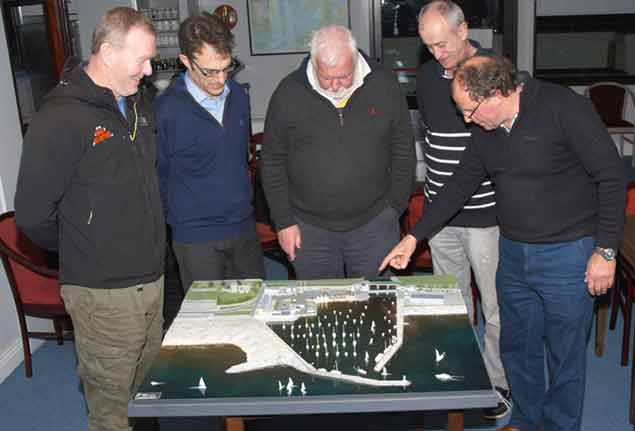 Stakeholders - (from left) John McNulty, Bray Adventures Ronan Laffan, Bray Sailing Club, Tony Foran, Bray Harbour Mooring Holders' Association, Greg Mulvaney, Bray Head Fishing and Social Club, Ger Crowley, Chairman BHAG with a model to show how Bray harbour could be improved
Stakeholders - (from left) John McNulty, Bray Adventures Ronan Laffan, Bray Sailing Club, Tony Foran, Bray Harbour Mooring Holders' Association, Greg Mulvaney, Bray Head Fishing and Social Club, Ger Crowley, Chairman BHAG with a model to show how Bray harbour could be improved
We believe, he continued, that for a relatively modest investment the harbour can again become a safe docking and berthing facility for coastal cruises and visiting boats bringing many visitors to the town. It can also become a centre for water sports and commercial water based activities.
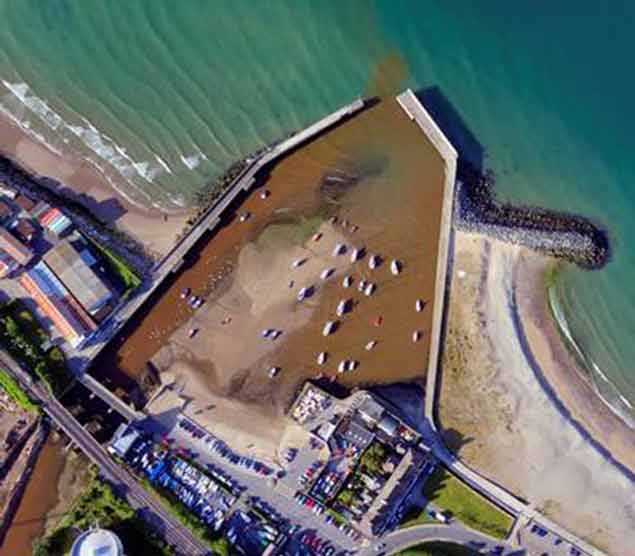 An aerial view of Bray harbour showing the current silt–up of sand in the Wicklow leisure port
An aerial view of Bray harbour showing the current silt–up of sand in the Wicklow leisure port
Speaking after the meeting, Ger said, BHAG welcomes the invitation from Bray Municipal District Councillors to form a Joint Working Group to explore how to maximise the potential of Bray Harbour and looks forward to working in close cooperation with Councillors and Officials to achieve positive outcomes.
He cautioned, however, that failure to deal with the build-up of sand in the harbour quickly and efficiently would not only put plans for the future in jeopardy but could lead to the early demise of the harbour as a valuable recreational amenity
Hazardous Waste Polluting Coast At Former Bray Landfill Site
#Pollution - An old landfill site in Bray continues to leak hazardous waste into the Irish Sea, according to TheJournal.ie.
Broken asbestos tiles and potassium deposits are among the pollutants leaching into the water due to coastal erosion at the former landfill — an issue highlighted recently by Ireland South MEP Liadh Ní Riada, who also noted similar sites in Waterford, Cork and elsewhere.
Afloat.ie previously reported on the disused rubbish tip north of the Co Wicklow seaside town two years ago, citing Coastwatch’s claim that the problem has existed for more than two decades as 200m of the site has been exposed to weathering and wave action.
Commenting on the issue in the Dáil, Environment Minister Denis Naughten said it was a matter for the local authorities concerned, and that an Environmental Risk Assessment was advised over a year ago.
TheJournal.ie has more on the story HERE.
Big Welcome Home for Row-A-Round Ireland Team
A crew of 20 rowers who set off to circumnavigate the island of Ireland – a round trip of almost 1000 nautical miles – in a self-built 15ft skiff to raise funds for Cystic Fibrosis Ireland (CFI) have today arrived home after a challenging four months at sea.
The team, comprising 20 rowers of mixed ability and experience, set off from Bray, Co. Wicklow on May 30th with crews of two oarsmen/women at a time rowing in relays. The rowers stopped at over 50 designated points along the coast before arriving home to a warm welcome from friends and family and members of the Bray community.
‘Row-A-Round Ireland’ is the brainchild of Bray-based maritime enthusiast Ger Crowley, who says the success of the trip was down to the dedicated crew of rowers and volunteers and the communities who came out to support the Row-A-Round Ireland team nationwide.
“It’s was an ambitious project, a journey of almost 1000 nautical miles, but I am delighted to say we have arrived home today after completing the challenge safely. I’d like to take this time to thank each and every individual who provided support to this challenge whether it was by offering accommodation or providing invaluable local knowledge – we couldn’t have done it without the Irish people doing what they do best,” Crowley said.
“The other objective, of course, was to raise funds and awareness for Cystic Fibrosis Ireland. At the start of this initiative, we all decided upon a target we would like to hit, and while we have raised a huge amount so far, we are going to give it one last push over the next few weeks to hit that top note,” he said.
Their arrival was met with celebrations as the crew enjoyed a welcome home party on Bray Beach and Harbour with refreshments from Row-A-Round Ireland sponsor, Lyons Tea.
The team heavily relied on local community support along the way, with many members of the maritime community including rowing, sailing and diving clubs around the country providing support by offering food, accommodation as well as valuable advice and local knowledge.
Funds have been made as the boat rowed around the county, with all money going towards fighting Cystic Fibrosis, a fatal genetic disease that affects approximately one in 1600 births in Ireland, the country with the highest incidence of CF in the developed world.
To donate to Cystic Fibrosis Ireland simply text ROW4CF to 50300 to donate €4 or to get in touch with the crew in relation to the challenge visit www.rowaroundireland.com.
Coastal Rowers Take on the Whole of Ireland
A team of 20 rowers have been circumnavigating the island of Ireland in a small, self-built skiff to raise funds for Cystic Fibrosis Ireland (CFI). Their plan for today (Thursday) is row up the Co Down coast to Blackhead, and then on to Portavogie.
The rowers, of mixed ability and experience, set off from Bray, Co. Wicklow on May 30th with crews of two oarsmen/women at a time rowing in relays. The rowers have planned stops at 50 designated points along the coast, with support on hand from a shore-based crew as well as cover boats that will escort the boat on some of the more challenging legs.
The team is particularly thankful for the support of local people, and some rowers can join the crew along the way.
‘Row-A-Round Ireland’ is the brainchild of Bray-based maritime enthusiast Ger Crowley, who said the trip was a huge challenge for all involved.
“It’s an ambitious project, a journey of almost 1,000 nautical miles, and the main objective is to safely row an open 15ft timber skiff around the island,” Crowley said. “Each two-person crew will contribute 100 miles towards the overall voyage over a period of a week or so, rowing on average up to 20 miles per day, so it’s a big ask for all our volunteers.
“The other objective, of course, is to raise funds and awareness for Cystic Fibrosis Ireland and all our rowers are giving their time and effort for free,” he says.
The Row-A-Round Ireland crew is drawn mainly from the immediate Crowley family and friends, under the watchful eye of team mascot and coxswain Joey the labrador. A true sea dog, Joey has a regular spot in the stern of the boat as it makes its way up and down the Bray coast on training rows. Although the journey will consist of 50 one-day legs, the changeable Irish weather means the crew has allowed 120 days to complete the challenge safely.
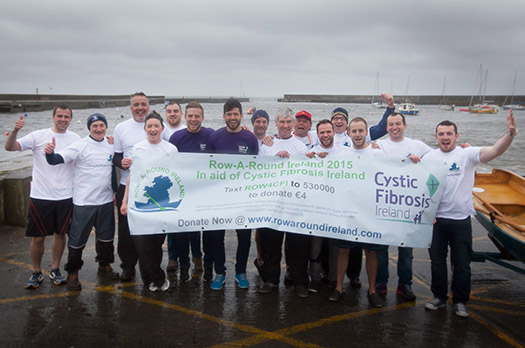
“Weather is going to be an issue alright, and there are some treacherous stretches of water to be navigated including Donegal Bay which comprises some 30 miles of the open Atlantic Ocean, Clew Bay, the Cliffs of Moher and from Loop Head across the mouth of the mighty Shannon,” says Ger Crowley, who built the boat.
The challenge also involves shore-based logistical support with a vehicle following the crew on land bringing change-over crews to intended landing areas, spares for repairs, food and also serving as a retrieval vehicle here beach landings are involved.
The team is also counting on local community support along the way, with many members of the maritime community including rowing, sailing and diving clubs around the country having pledged their support by offering food, accommodation as well as valuable advice and local knowledge.
Funds will be raised as the boat makes its way around Ireland, with all money going towards fighting Cystic Fibrosis, a fatal genetic disease that affects approximately 1 in 1600 births in Ireland, the country with the highest incidence of CF in the developed world.
#RNLI - Dun Laoghaire RNLI was involved in the recovery yesterday afternoon of a sinking boat following the rescue of three people after the vessel began to sink off the Wicklow coast.
Three people were pulled from the water when their small boat got into difficulty off Bray on Sunday 12 May.
A local boat responded to the Mayday alert and brought the casualties to safety.
The RNLI lifeboat from Dun Laoghaire and the Greystones Coast Guard boat took the boat that was almost fully submersed under tow to shore.
Winds gusted to storm force towards the end of the operation but conditions were otherwise fresh, with only choppy waves off the coast.
The incident occurred shortly after midday when the 15ft speedboat was almost one mile from Bray Harbour.
One Week Left to Catch 'Shark Week' at Sea Life Bray
#MARINE WILDLIFE - There's still a week left to check out the Shark Week celebrations at Sea Life Bray.
Till 4 November the centre on the promenade in Bray, Co Wicklow will be hosting events that take a closer look at one of nature's most magnificent but misunderstood creatures.
In an urgent bid for shark conservation, Sea Life is supporting the UK-based Shark Trust by throwing the spotlight on sharks - raising awareness about the wide range of shark species in British and Irish waters, and the challenges they and other marine wildlife are facing.
Kids can get involved with badge making, puzzles and games, shark-related quizzes and activity sheets, and even see the centre's sharks - which include bonnet head shark, leopard shark and blacktop reef shark - get their dinner at the shark feeding times!
The full timetable for Shark Week related events at Sea Life Bray is available HERE.




























